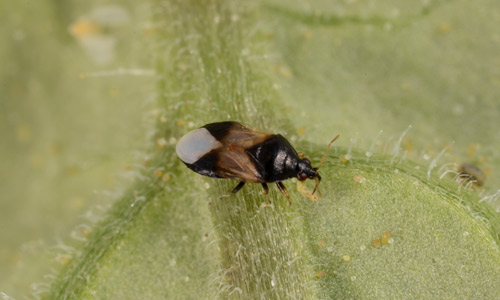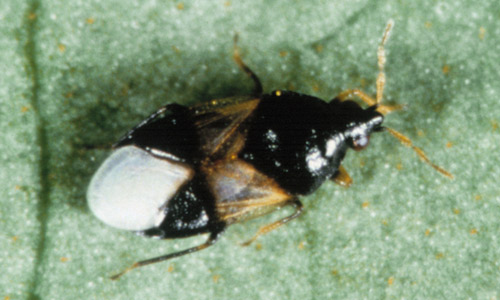common name: insidious flower bug, minute pirate bug
scientific name: Orius insidiosus Say (Insecta: Hemiptera: Anthocoridae)
Introduction - Distribution - Description - Life Cycle and Biology - Hosts - Economic Importance - Selected References
Introduction (Back to Top)
The insidious flower bug, Orius insidiosus Say, is a common predator of a wide variety of small, soft-bodied arthropods (Figure 1). Orius insidiosus is in the family Anthocoridae. Species of the genus Orius are commonly referred to as minute pirate bugs, while the common name for Orius insidiosus is the insidious flower bug (Funderburk 2009). Orius insidiosus is an important predator of many economically important pests (Lattin 1999, Funderburk et al. 2000, Silveira et al. 2004, Xu et al. 2006). In Florida, Orius insidiosus receives recognition for being the key predator of a major economic pest, the western flower thrips, Frankliniella occidentalis (Funderburk et al. 2000, Funderburk 2009).
Figure 1. The insidious flower bug, Orius insidiosus Say, feeding on a thrips larva. Photograph by Lyle J. Buss, University of Florida.
Distribution (Back to Top)
Orius insidiosus is most common in the eastern United States, although it occurs across the southwestern United States to Utah and southern California, then south into Mexico and Central and South America (Herring 1966). It also occurs in Cuba, Puerto Rico, and many other islands of the West Indies (Herring 1966).
Description (Back to Top)
Eggs: The eggs of Orius insidiosus are 0.4 mm long (Green Methods 2016). Adult females deposit eggs within plant tissue (Lattin 1999).
Nymphs: The nymphs of Orius insidiosus are less than 3 mm in length, wingless and teardrop-shaped (Lattin 1999). They range from yellow-orange to brown in color (Wright 1994) (Figure 2). The first instar is slightly yellow and later instars become progressively darker in color (Funderburk 2016).
Figure 2. Nymph of Orius insidiosus Say. Photograph by Lyle J. Buss, University of Florida.
Adults: The adults of Orius insidiosus are approximately 3 mm long (Lattin 1999). They are oval and black with white wing patches. The wings extend beyond the abdomen. Adults have a long proboscis used for sucking plant juices and consuming prey (Wright 1994) (Figure 3).
Figure 3. Orius insidiosus Say adult. Photograph by James Castner, University of Florida.
Life Cycle and Biology (Back to Top)
Orius insidiosus has multiple generations per year. The total developmental time from egg to adult is approximately three weeks (Wright 1994). Adult females lay their eggs within plant tissues (Lattin 1999). Eggs hatch in six to ten days (Funderburk 2016). Orius insidiosus undergoes incomplete metamorphosis, and nymphs develop through five instars (Wright 1994). Development of the nymph requires at least ten days, depending on temperature (Funderburk 2016). Adults live for approximately three to four weeks (Wright 1994, Lattin 1999). Nymphs and adults are highly mobile. When day length is less than 14 hours, adults will enter a quiescent resting state (Ruberson et al. 2000). They are active from March to November in northern Florida and year-round in southern Florida (Funderburk 2016).
Hosts (Back to Top)
Orius insidiosus is found in a wide range of agricultural crops and natural habitats (Wright 1994). It is attracted to flowers and plants that have soft-bodied insects feeding on them (Wright 1994). Pollen and plant juices are known to be used as food when prey is scarce (Lattin 1999). Nymphs and adults feed on a variety of small prey, including thrips, mites, aphids, whiteflies, scale insects, small caterpillars, and eggs of various insects (Lattin 1999).
Although a generalist predator, Orius insidiosus has a preference for flower thrips (Thysanoptera: Thripidae) (Baez et al. 2004). In Florida, it preys on the adult and larval stages of many species of thrips, including Frankliniella occidentalis (Pergande), Frankliniella tritici (Fitch), and Frankliniella bispinosa (Morgan). Frankliniella occidentalis larvae are the preferred prey of Orius insidiosus (Funderburk et al. 2000, Baez et al. 2004).
Economic Importance (Back to Top)
Species of Orius have been successfully used as biological control agents against Frankliniella occidentalis in chrysanthemum (Silveira et al. 2004), cucumber (Chamber et al. 1993), sweet pepper (Funderburk et al. 2000), eggplant (Funderburk 2009), and strawberries (Frescata and Mexia, 1996). Funderburk et al. (2000) reported that the ability of Orius insidiosus to suppress populations of thrips in Florida field-grown pepper exceeded the suppressive effects of weekly insecticide applications. At a ratio of one predator to 180 thrips, thrips populations were suppressed and, at a ratio of one predator to 40 thrips, thrips populations were controlled below economic thresholds (Funderburk 2009).
A study by Xu et al. (2006) found that Orius insidiosus can suppress populations of the two-spotted spider mite, Tetranychus urticae Koch (Arachnida: Acari: Tetranychidae), on bean plants. Suppression of the two-spotted spider mite was achieved when two bugs were released for control of an initial density of 40 spider mites. Orius insidiosus is also an important predator of soybean aphid, Aphis glycines (Hemiptera: Aphididae) in soybean fields (Lattin 1999).
Applications of most broad spectrum insecticides, such as pyrethroids, neonicotinoids, organophosphates, and carbamates, eliminate Orius insidiosus populations (Funderburk et al. 2000). However, Orius insidiosus can be conserved through the careful use of reduced-risk insecticides and the adoption of economic thresholds rather than preventative insecticide applications (Funderburk et al. 2000, Demirozer et al. 2012). In addition, maintaining beneficial plant habitats and refugia plantings that serve as hosts for Orius insidiosus can also help increase and maintain populations (Funderburk 2009, Demirozer et al. 2012).
Orius insidiosus is commercially available for mass release. Release rates vary among the type of crop and the level of thrips infestation (Silveira et al. 2004). For horticultural crops, release rates of one to two predators/m2 per release are usually used (Sanchez et al. 2000, Silveira et al. 2004). Orius insidiosus is shipped in the adult stage. Commercial producers of Orius insidiosus recommend its use in greenhouses, fields, interiorscapes, orchards and gardens.
Selected References (Back to Top)
- Baez I, Reitz SR, Funderburk JE. 2004. Predation by Orius insidiosus (Heteroptera: Anthocoridae) on life stages and species of Frankliniella flower thrips (Thysanoptera: Thripidae) in pepper flowers. Environmental Entomology 33: 662-670.
- Chamber RJ, Long S, Sand NL. 1993. Effectiveness of Orius laevigatus (Hem: Anthocoridae) for control of Frankliniella occidentalis on cucumber and pepper in the UK. Biocontrol Science Technology 3: 295-307.
- Demirozer O, Tyler-Julian K, Funderburk JE, Leppla, N, Reitz S. 2012. Frankliniella occidentalis (Pergande) integrated pest management programs for fruiting vegetables. Pest Management Science 68: 1537-1545.
- Frescata C, Mexia A. 1996. Biological control of thrips by Orius laevigatus (Heteroptera: Anthocoridae) in organically-grown strawberries. Biological Agriculture & Horticulture 13: 141-148.
- Funderburk JE, Stavisky J, Olson S. 2000. Predation of Frankliniella occidentalis (Thysanoptera: Thripidae) in field peppers by Orius insidiosus (Hemiptera: Anthocoridae). Environmental Entomology 29: 376-382.
- Funderburk JE. 2009. Management of the western flower thrips (Thysanoptera: Thripidae) in fruiting vegetables. Florida Entomologist 92: 1-6.
- Funderburk JE. 2016. Biological control: Minute pirate bug, Orius insidiosus. IPM IFAS, University of Florida. (26 February 2016)
- Green Methods. (2016). Orius for thrips control. California, United States. (18 April 2016)
- Herring JL. 1966. The genus Orius of the Western Hemisphere (Hemiptera: Anthocoridae). Annals of the Entomological Society of America. 59: 1093-1109.
- Lattin, J. D. 1999. Bionomics of the Anthocoridae. Annual Review of Entomology 44: 207-231.
- Reitz SR, Yearby EL, Funderburk JE, Stavisky J, Momol MT, Olson SM. 2003. Integrated management tactics for Frankliniella thrips (Thysanoptera: Thripidae) in field-grown pepper. Journal of Economic Entomology 96: 1201-1214.
- Ruberson JR, Shen YJ, Kring TJ. Photoperiod sensitivity and diapause in the predator Orius insidiosus (Heteroptera: Anthocoridae). Annals of the Entomological Society of America. 93: 1123-1130.
- Sanchez JA, Alacazar A, Lacasa A, Llamas A, Bielza, P. 2000. Integrated pest management in sweet pepper plastic houses in the southeast of Spain. IOBC/WPRS Bulletin 23: 21-30.
- Silveira LCP, Bueno VHP, van Lenteren JC. 2004. Orius insidiosus as biological control agent of thrips in greenhouse chrysanthemums in the tropics. Bulletin of Insectology 57: 1-6.
- Wright B. 1994. Know your friends: Minute pirate bugs. Midwest Biological Control News Online, University of Nebraska-Lincoln. (26 February 2016)
- Xu X, Borgemeister C, Poehling HM. 2006. Interactions in the biological control of western flower thrips Frankliniella occidentalis (Pergande) and the two-spotted spider mite Tetranychus urticae Koch by the predatory bug Orius insidiosus Say on beans. Biological Control 36: 57-64.


